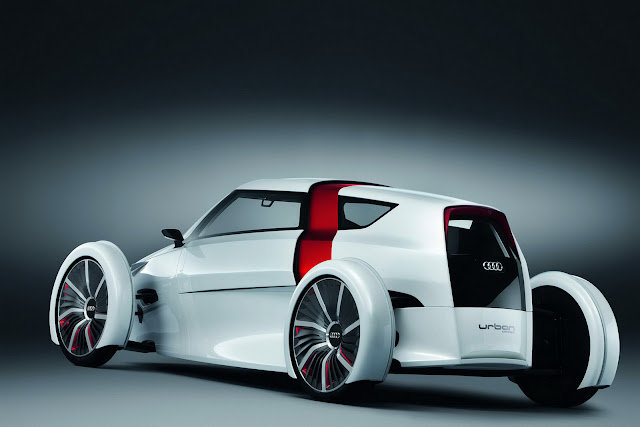In the media presentation at Frankfurt motorshow, Audi revealed not one, but two if its Urban concept car. The Urban Sportback is a fixed roof version, albeit the canopy roof can be slide rearwards to access the futuristic cabin. The Urban Spider on the other hand has a upwards swing door, enclose by low height fixed glass.
Both cars are 3219mm long, 1678mm wide and 1189mm tall for Sportback, the roadster could be a little lower due to lack of roof. Both are powered by electric drivetrain, truth to the concept car of 2011! The car above is the Sportback, while the bottom one is the Urban Spider. More photos and details after the jump.
Both car share similar looks, with differentiation only comes in detailing in the roof region. The front end of the car features Audi current grille design, a hexagonal shaped, flanked by slim headlamps garnished with LED lighting. Both car are open-wheeler concept, with LED strip fitted along the arch at both end.
Although strictly slim, with no conventional design element, the Urban concept still indirectly featured contemporary Audi design cues. The taut body surfacing, combined with tight shutline and graceful LED graphics are pure modern Audi. Rear light arched the rear window, and indicators are as previously-mentioned, lining up on the wheelcover.
Other pure concept touch are slide-out boot. Commonly seen on 90's concept car, this makes a return to Frankfurt in 2011.
The door are sliding type, with rearward motion to access the cabin. High sill is prominent in the design, with only the top portion of the door that is sliding.
As much as it is futuristic, the car is said to be inspired by Auto Union race cars of the 30's. This is particularly obvious from the top view. This is the car of 30's race car, and in case of Auto Union, they had a gaping mouth in front too, which is clearly demonstrated by this Urban Concept.
The cabin seats two in tandem, where the passenger is slightly offset from the driver. This saved the required space length-wise and maximised the available space for other utilization.
The instrument panel is minimalist. There are only two controls for climate control. Driving information and navigation are displayed in the screen ahead of the driver. Flooring is made of textile, similar to athletic shoes which are water repellant.
Underneath the skin, the car is powered by two electric motors producing 20hp and 47Nm of torque. The motors are mounted at the back, driving the rear wheel via single speed gearing system. Motivation for the motor is provided by lithium-ion battery, mounted transversely behind the seat and weights 90kg.
The drivetrain gives the car a 6.0 second sprint to 60km/h and 16.9 seconds to 100km/h which is its electronically limited top speed too. Estimated range is 73km and charging time is one hour using household 230V outlet.
The car is lightweight in its contruction. Outer body panel is a CFRP, while the chassis is a mixture of CFRP and aluminum. This gives it a 480kg at the scales. The 21" wheels are covered with 125/60 and 145/50 tyres for front and rear respectively, which is turns is suspended by pushrod suspension.











